![]()
![]()
![]()
Use LEFT and RIGHT arrow keys to navigate between flashcards;
Use UP and DOWN arrow keys to flip the card;
H to show hint;
A reads text to speech;
18 Cards in this Set
- Front
- Back
|
Moi mechanism of the injury
|
Blunt trauma, penetrating trauma
|
|
|
Noi nature of illness
|
Medical patients similarities between MOI and NO I... Carbon monoxide poisoning is an example
|
|
|
Triage
|
Process of sorting patients based on the severity of each patient's condition
|
|
|
Primary assessment
|
Begins when you greet your patient. Primary assessment does not include vital signs. ABC airway breathing circulation
|
|
|
General impression
|
Based on your immediate assessment. Make a note of the persons age sex race, level of distress, overall appearance. Assess the patient's skin color and condition. Determine if the patient's condition is stable stable. Potentially unstable or unstable ( let's move find out more on the way)
|
|
|
LoC level of consciousness
|
Tells a lot about a patient's neurologic and physiologic status
|
|
|
Levels of consciousness
|
Conscious with an unaltered LOC
conscious with an altered LOC Unconscious |
|
|
Assessment of an unconscious patient
|
Airway breathing circulation
|
|
|
AVPU
|
awake and alert
Responsive to verbal stimuli Responsive to pain Unresponsive |
|
|
How to test for responsiveness to painful stimuli
|
Pinch earlobe
Press down on bone above eye Pinch neck muscles |
|
|
PEARRL
|
Pupils
Equal and round Regular in size React to light |
|
|
cyanotic
|
blue
|
|
|
breathing assessment
|
sound & moving
|
|
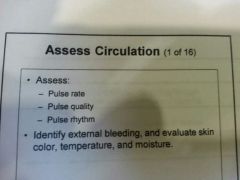
|
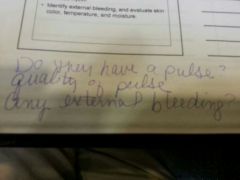
|
|
|
SAMPLE
|
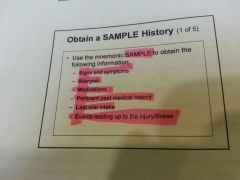
|
|
|
Secondary assessment
|
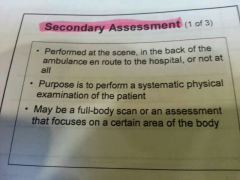
|
|
|
Secondary assessment
|
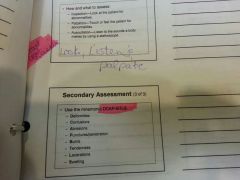
|
|
|
reassessment
|
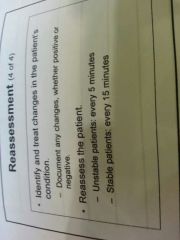
|

